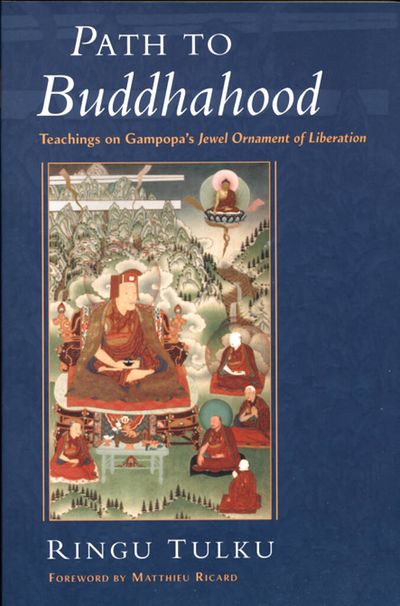Path to Buddhahood: Teachings on Gampopa's Jewel Ornament of Liberation
No edit summary |
No edit summary |
||
| (6 intermediate revisions by 3 users not shown) | |||
| Line 1: | Line 1: | ||
{{Book | {{Book | ||
|TileDescription=Teachings by the contemporary Tibetan teacher Ringu Tulku on Gampopa's beloved work on the stages of the path to enlightenment. | |||
|BookPerson={{Book-person | |BookPerson={{Book-person | ||
|PersonPage=Ringu Tulku | |PersonPage=Ringu Tulku | ||
|PersonName=Ringu Tulku | |PersonName=Ringu Tulku | ||
}}{{Book-person | }}{{Book-person | ||
|PersonPage= | |PersonPage=sgam po pa | ||
|PersonName= | |PersonName=Gampopa | ||
}} | }} | ||
|FullTextRead=No | |FullTextRead=No | ||
|TextTranslated=Texts/Dam chos yid bzhin gyi nor bu thar pa rin po che'i rgyan | |||
|BookEssay=The Dagpo Tarjen<ref>1 Dvag po thar rgyan.</ref> or The Jewel Ornament of Liberation<ref>2 The Dagpo Tarjen was first translated into English by Herbert V. Guenther under the title The Jewel Ornament of Liberation (Berkeley: Shambhala, 1971). It was subsequently translated by Ken and Katia Holmes as Gems of Dharma, Jewels of Freedom (Forres, Scotland: Altea Publishing, 1995). A third translation, by Khenpo Konchog Gyaltsen Rinpoche, has been published under the original title, The Jewel Ornament of Liberation (Ithaca, N.Y.: Snow Lion Publications, 1998). </ref> of Gampopa is one of the most important texts of Tibetan Buddhism. In the Kagyu<ref>3 The Kagyu or Kagyupa (bka' brgyud pa) is one of the four main schools of Tibetan Buddhism. The other three are Nyingma (rnying ma), Gelug (dge lugs), and Sakya (sa skya).</ref> tradition it is the main text used in the instruction of monks. It is sometimes referred to as the "merging of the two streams" because Gampopa here combines two traditions or currents of Dharma teachings, that of the Mahayana Kadampa<ref>4 The Kadampa (bka' gdams pa) tradition traces its origin to the Mahayana (Great Vehicle) teachings of Atisha from the lineage of Nagarjuna and Asanga. It no longer exists as a separate tradition but has been incorporated into the four major contemporary schools of Tibetan Buddhism.</ref> tradition and that of the tantric Mahamudra<ref>5 The yogic experiential tradition from the lineage of the Indian panditas Tilopa and Naropa and from them to Marpa and Milarepa. Mahamudra (literally, "great seal") is the highest teaching of the Kagyu tradition. </ref> tradition. | |||
Gampopa's teachings brought these two traditions together in such a way that they could be practiced together as one experience. They quickly became one of the most important and effective foundation texts used in the teaching of Buddhism in Tibet from the eleventh century onward. The whole Kagyu tradition is based mainly on this teaching. | |||
====The Author==== | |||
Gampopa was born in 1079 and died in 1153. Despite his renown as a physician, he was unable to save his wife and two children, who died in an epidemic that ravaged the region where they lived. Full of grief, he came to a deep understanding of the transitory nature of all things and the inherent suffering that this implied. He renounced the world and devoted himself totally to spiritual practice, seeking a way out of the suffering of samsara. Gampopa became a monk and for many years followed the teachings of the Kadampa geshes<ref>6 A geshe (dge bshes) is a scholar with a profound knowledge of the sutras and the Buddhist teachings.</ref> of the time. One day he happened to hear the name of Milarepa, the famous Tibetan yogic poet, and intense devotion immediately arose in him. Deeply inspired, he began to cry and left at once to seek out Milarepa. | |||
After many hardships Gampopa arrived near the place where the yogi was staying. Having traveled without any rest, Gampopa was by now ill and exhausted. The people in the local village took him in and treated him with great respect and hospitality. "You must be the one whom Milarepa spoke of," they said. "What did he say about me?" asked Gampopa. The villagers replied that Milarepa had predicted his arrival, telling them, "A monk from Ü<ref>7 Central Tibet.</ref> is coming. He is a very great bodhisattva and will be the holder of my lineage. Whoever shows him hospitality when he first arrives will be liberated from samsara and will enjoy the best of good fortune." | |||
When Gampopa heard this, he said to himself, "I must be a very special person." Feelings of pride and conceit arose in his mind, and, consequently, when he went to meet Milarepa in his cave, the latter refused to see him. He had Gampopa wait in a nearby cave for fifteen days. When he was finally allowed to see Milarepa, Gampopa found the yogi sitting there with a skull cup full of wine. He handed the skull to Gampopa and invited him to drink. Gampopa was perplexed. He was a fully ordained monk and as such had vowed to abstain from alcohol. Yet here was Milarepa commanding him to drink. It was unthinkable! So great, however, was Gampopa's trust and devotion to his guru that he took the skull cup and drained it of every drop. | |||
This act had a very nice and auspicious significance, as it showed that Gampopa was completely open and ready to receive the entirety of Milarepa's teachings and full realization. It is said that how much a student can benefit from a teacher depends upon how open he or she is. Although Gampopa was a very good monk, he drank the skull cup of wine without any hesitation or reservation, which signified that he was completely open and without the slightest doubt. | |||
Milarepa subsequently gave Gampopa his complete teachings, and within a very short time Gampopa became his best and most realized student.<ref>8 A fuller account of Gampopa's meeting and relationship with Milarepa can be found in Garma C. C. Chang, trans., The Hundred Thousand Songs of Milarepa (New Hyde Park: University Books, 1962). See also Jampa Mackenzie Stewart, The Life of Gampopa (Ithaca, N.Y.: Snow Lion Publications, 1995).</ref> In Gampopa's teachings we therefore find the scholarly erudition and discipline of his monastic tradition combined with the total realization of a fully accomplished yogi, which he received through Milarepa. | |||
The present commentary relies mainly on the original Tibetan text but draws upon both Guenther's and Holmes's translations where necessary. | |||
<references/> | |||
|BookToc=** {{i|Foreword| xi}} | |BookToc=** {{i|Foreword| xi}} | ||
** {{i|Preface| xv}} | ** {{i|Preface| xv}} | ||
| Line 64: | Line 79: | ||
* {{i|Conclusion| 169}} | * {{i|Conclusion| 169}} | ||
* {{i|Dedication of Merit| 171}} | * {{i|Dedication of Merit| 171}} | ||
* {{ | * {{i|Notes| 173}} | ||
* {{i|Index |179}} | * {{i|Index |179}} | ||
|AddRelatedTab=No | |AddRelatedTab=No | ||
|PostStatus=Needs Copy Editing | |PostStatus=Needs Copy Editing | ||
|StopPersonRedirects=No | |||
|BookParentPage=Library | |||
}} | }} | ||
Latest revision as of 11:58, 23 September 2020
The Jewel Ornament of Liberation is regarded by all Tibetan Buddhist schools as one of the most inspiring and comprehensive works of the tradition. Written by Gampopa (born 1079 CE), the main spiritual son of the great hermit Milarepa, this important text lays out the stages of the Buddhist path and explains how an enlightened attitude is strengthened by practicing the six perfections of generosity, discipline, patience, exertion, meditation, and knowledge. (Source: Shambhala Publications)
| Citation | Ringu Tulku Rinpoche. Path to Buddhahood: Teachings on Gampopa's Jewel Ornament of Liberation. Edited by Maggy Jones, Briona Nic Dhiarmada, and Corinne Segers. Boston: Shambhala Publications, 2003. Originally published in French as Et si vous m'expliquiez le bouddhisme? Paris: Nil Editions, 2001. |
|---|---|



